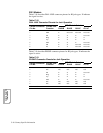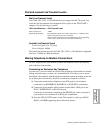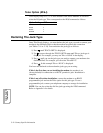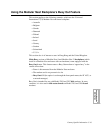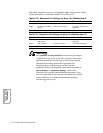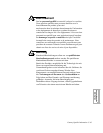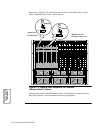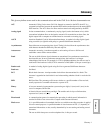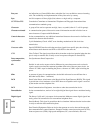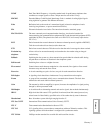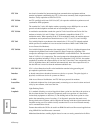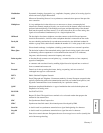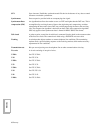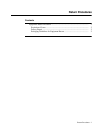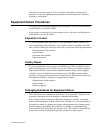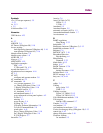
2-Glossary
Glossary
Busy out An indication to a Central Office that a subscriber line is not available to answer incoming
calls. The availability and implementation of Busy Out varies by country.
Byte An 8-bit sequence of binary digits (bits) taken as a single unit by a computer.
CCITT. See ITU. Consultative Committee on International Telephone and Telegraph. International data
communications standards group.
Character A group of bits used to represent one digit, letter, or symbol (often in 7- or 8-bit groups).
Character-oriented A communications protocol that carries control information encoded in fields of one or
more characters. Compare with Bit-Oriented.
Control characters In data communications, any additional transmitted characters that control or facilitate data
transmission between data terminals.
CRC Cyclic Redundancy Check. A BCC error-checking mechanism for link-level data
transmission.
Crossover cable Special DTE/DCE interface cable that reassigns signals from specific pins, thus allowing
normal data transfer between two DTEs or two DCEs at the same site.
CTS Clear To Send. The signal passed from the local modem to the local terminal when the data
port is ready to transmit data. Usually occurs in response to Request To Send (RTS).
Data compression,
synchronous
See Synchronous Data Compression.
dB Decibel. A unit used to express relative difference in power between acoustic or electric
signals, equal to ten times the common logarithm of the ratio of the two power levels. An
increase of 3 dB is equal to doubling the power; a decrease of 3 dB is equal to halving the
power.
dBm A measure of power in communications: the decibel referenced to one milliwatt into a
600-ohm load (0 dBm = 1 milliwatt).
DCD Data Carrier Detect. Also known as the Received Line Signal Detector (RLSD). This signal
is passed from a local modem to a local DTE when an acceptable carrier signal is received
by the modem over the telephone line.
DCE Data Communications Equipment. A modem or other data transmission device.
Demodulation In data communications, retrieval of an original digital data signal from a modulated analog
signal.
Digital signal The binary 0 (off) and 1 (on) output of a data terminal. Modems convert digital signals into
analog waves for transmission over conventional telephone lines.
DSR Data Set Ready. This signal is passed from the local modem. Indicates that the local modem
is ready to enter the data transmission phase.
DTE Data Terminal Equipment. End user devices that generate or receive data and that provide
data communications control functions. Examples include: central processing units (CPUs),
front-end processors (FEPs), high-speed multiplexers, PCs, user terminals, and so on.



